

Keyboards
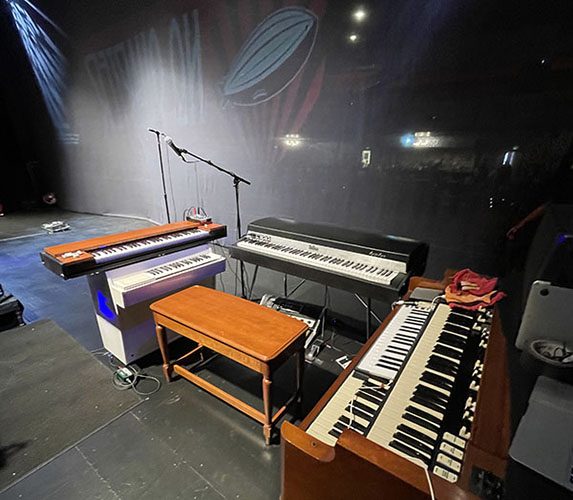
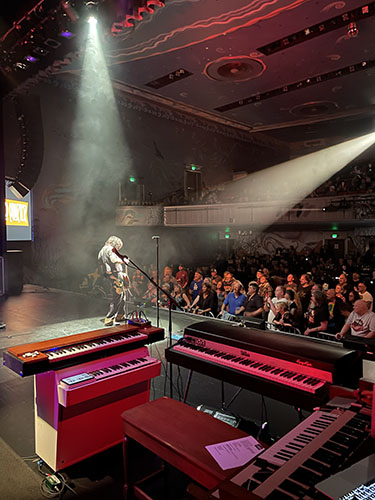
JPJ is so much more than a bassist. In the early 1960's, besides being a London session bassist, he was also a top arranger and keyboard player. So much of Zeppelin's expanded sound is due to his keyboard playing and arranging of what little real strings and other instruments Jimmy Paged put in the mix (besides his many layers of guitars).
I have been playing piano since age 5 or so, violin in 3rd grade, and only started playing bass in high school. While studying composition and piano at the Hartt School of Music, a classical music college in Hartford, CT, I played bass in a "progressive" rock cover band (which turned into a Rush tribute with me on bass and keys, with a generous helping of Zeppelin and Yes). I played keys professionally for the first half of the 1980's, but got tired of being the keyboardist in the corner of the stage that contributing little more than icing on top of the musical cake, so in around 1985 I sold my keys and concentrated on bass for the next 25 years (and had a blast doing it).
I got back into classical piano around 2002, and got my first digital keyboard in the longest time about 5 years after that - a Casio Privia. Originally purchased just to practice piano while I was between acoustic grand pianos, I started taking it out on gigs with a Who tribute to play keys on "Love Reign O'er Me". When I decided I wanted to make the switch to Zeppelin and JPJ, I realized I would have to dive back into full keyboard gear/programming/practice mode.
JPJ could afford any gear he wanted, and had a truck and rodies to move and setup grand pianos if he wanted them at every gig. I do not. One requirement of this gig is for the keyboard gear to be as light and compact as possible. I manage to get most of this stuff into 2 cases weighing 50lbs each, and check them in when flying to gigs outside of California. As of 2023 I have switched to in-ear monitoring and lighter/foldable controllers and vintage-style keyboard shells (some of which can fly with me), and this has turned out to be a great sounding and compact set-up, with all of the correct Zep key sounds at my disposal.
Ultra-portable Live 2025 JPJ Keyboard Rig (5/02/25)
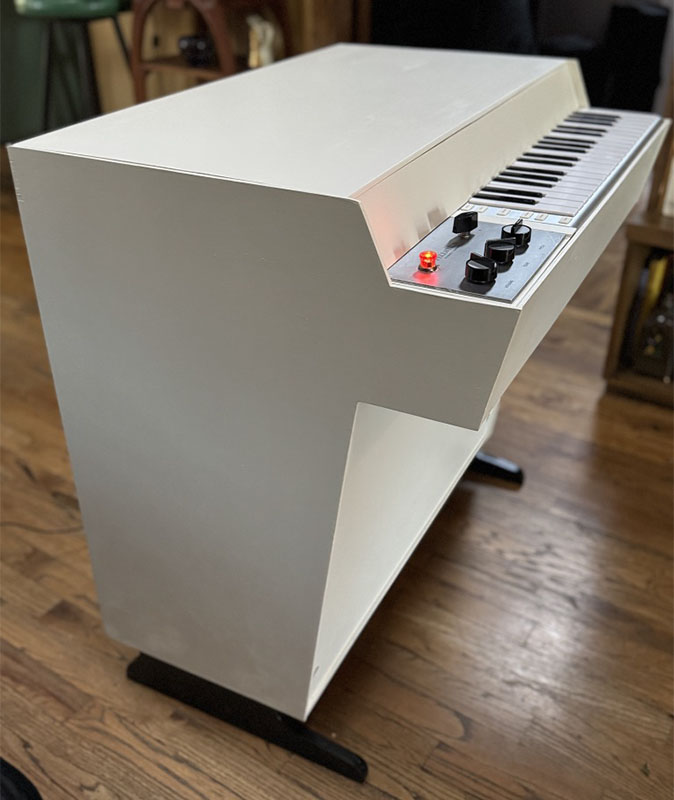
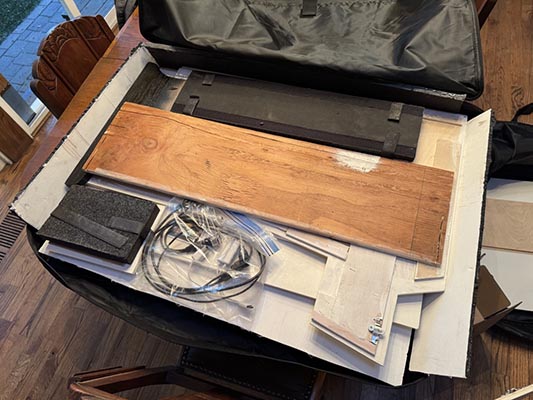
I've recently completed deign and construction of my 6th and latest Pellotron (a mellotron MIDI controller and shell), this one the lightest and most collapsible and transportable version yet. No screws required for assembly (all velcro strips to join the sections), almost all constructed out of lightweight 1/4" plywood (totalling 23lbs in the bag, and survived one fly-in gig with no damage SO FAR...), built around the ultra-slim but still dynamic and musical CME Xkey 37 MIDI controller. Its almost 100% to vintage spec, and reads 100% legit from the stage. Mounted on top of this is my 3rd Clavinet MIDI controller/shell, constructed around a very lightweight fold-up 61-key MIDI controller keyboard and made of 1/4" and 1/8" plywood, dense foam and more velcro to assemble. A weighted 88-key keyboard (for Rhodes and other keyboard parts) is generally provided by the production company, and everything plugs into a MacBook via USB running Mainstage (including sounds from Mainstage, Arturia and Modartt). I can now transport and use the full 1973-5 JPJ 3-keyboard rig for all Zeppelin tribute shows worldwide, along with 2 bass guitars (as seen in last photo), or 1 bass and 1 mandolin.
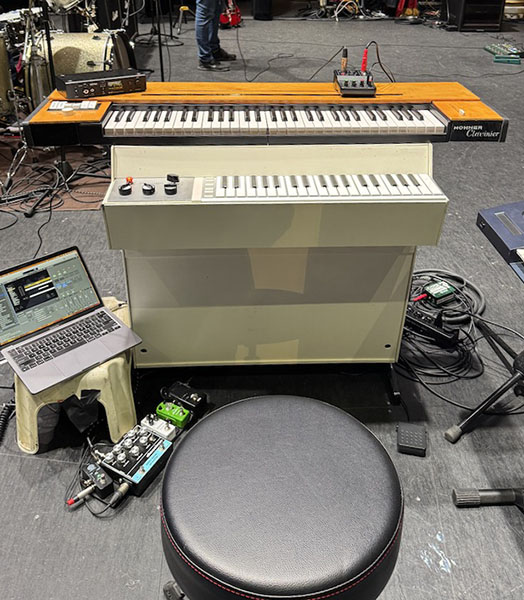
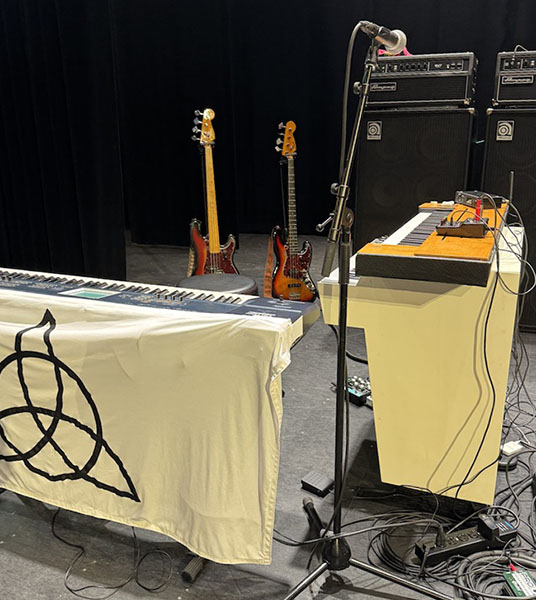
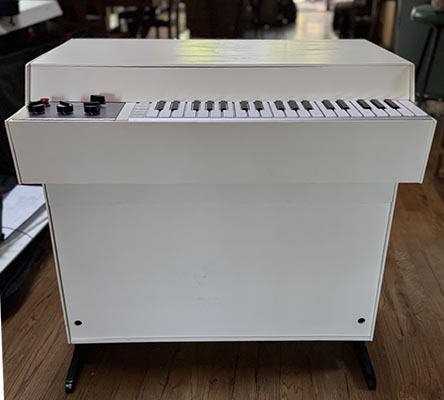
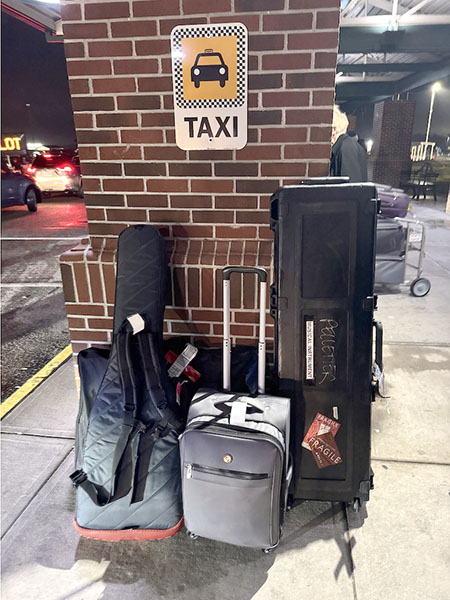
More about my Pellotrons (some are for sale!) at pellotron.com.Live 2024 JPJ Rigs (4/30/24)
I continue with my goal of building and performing with the most accurate-looking JPJ rig, which includes not only the basses, mandolin and bass amps, but the vintage keyboards. Yes, it's all theatre, and that means it's ATLEAST as much about how it LOOKS as how it sounds (otherwise the paying audience can just stay home and listen to actual Zeppelin recordings), so I believe the accuracy of the left side of the Zeppelin stage is very important from the audience perspective. My keyboard rig (all MIDi controllers in vintage-type shells when possible) now always includes three keyboards: a Rhodes piano, a Mellotron and a Clavinet, as seen in Zeppelin's THE SONG REMAINS THE SAME film from their 1973 US tour (JPJ's rig changes from tour to tour based on instrument availability and song list). I have the full correct-looking rig in the No Quarter trailer for all of their shows where the band provide backline; when flying in, I can still bring my dissasemblable Pellotron #2 and a fold-up white 61-key controller for the Clavinet and other keyboard parts, and the productions provide a weighted 88-key controller for the Rhodes parts. With Zeppelin Live I have another full Three-keyboard rig with my latest/greatest Faux Rhodes, another Clavinet shell with a 61-key controller, and the same Pellotron #2, all fitting (somehow) in my non-van.
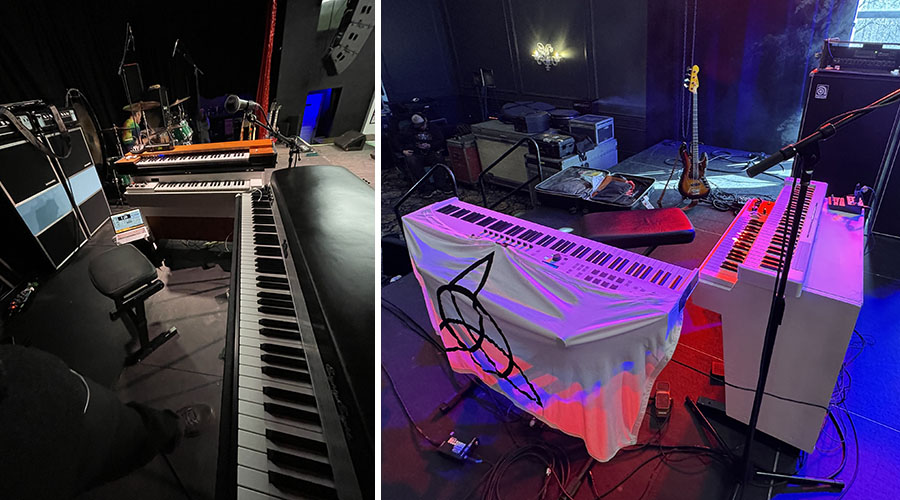
I post regularly about keyboard builds, stage photos and upgrades on my Facebook page facebook.com/johnpauljoelpelletier, which tends to be much more up to date than on this site (for now...).
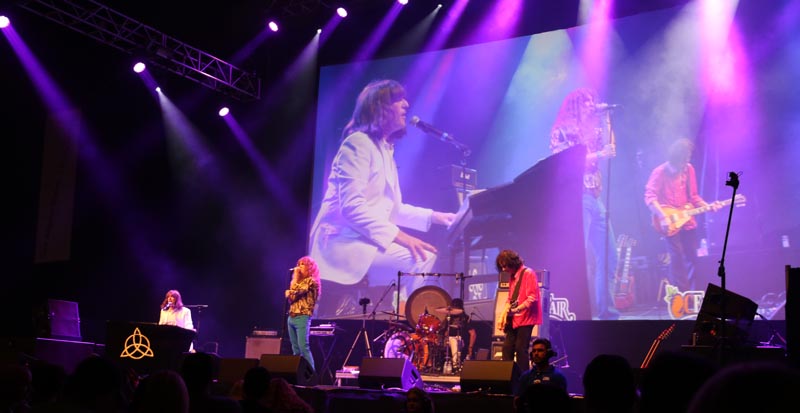
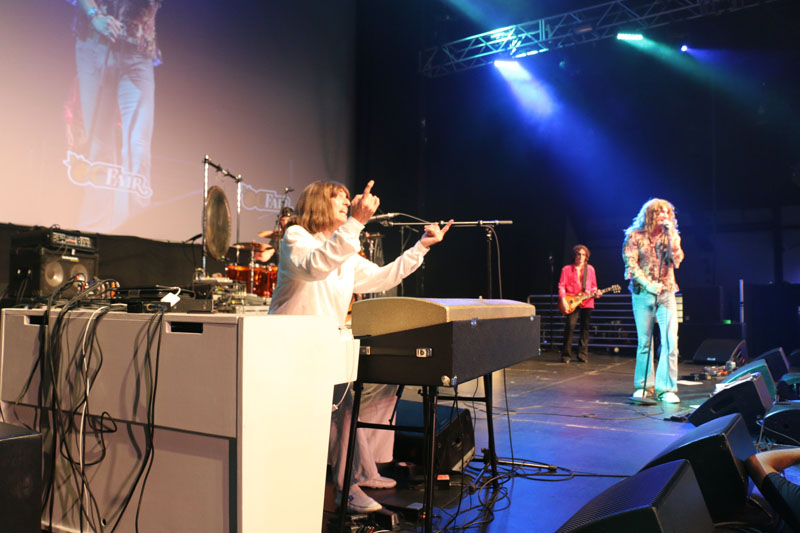
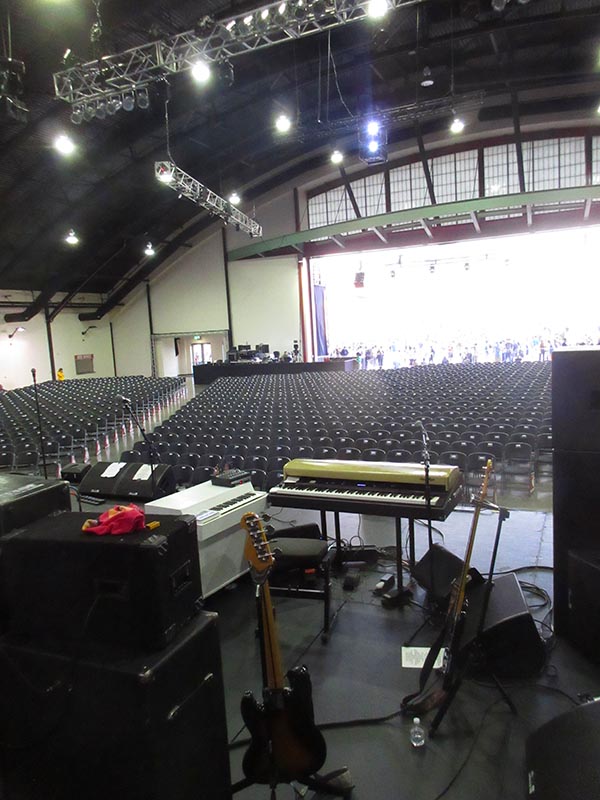
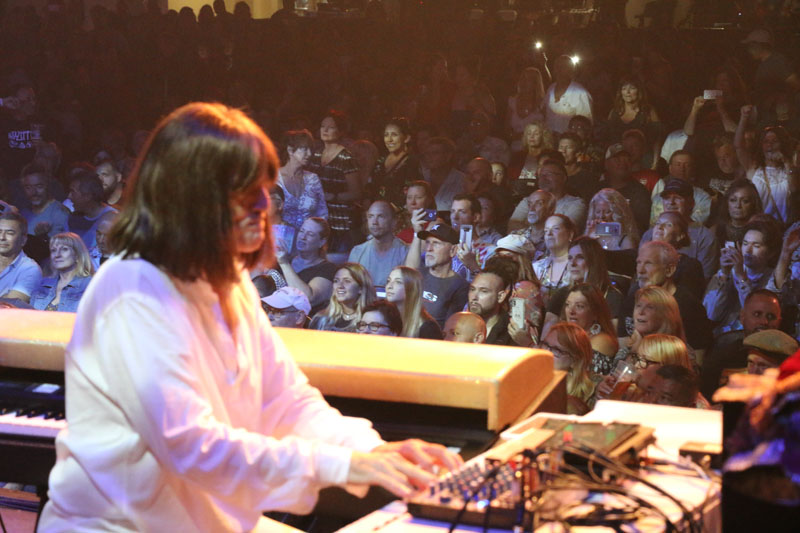
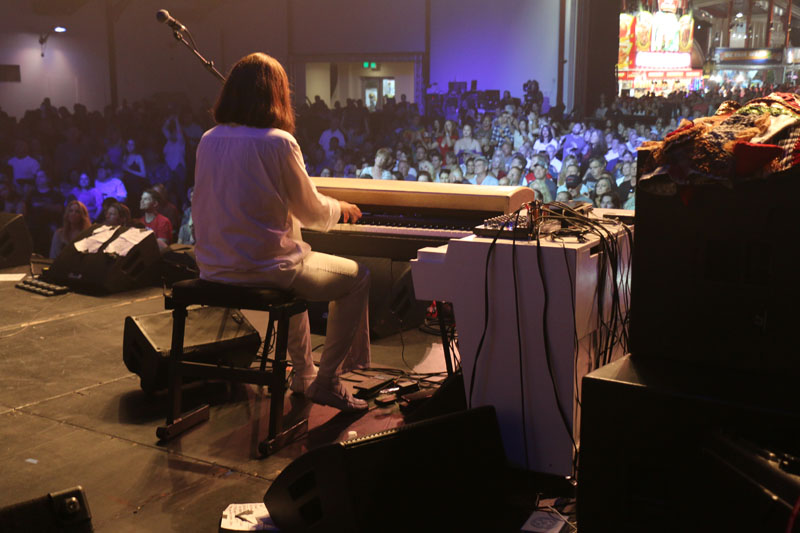
Performing SINCE I'VE BEEN LOVIN' YOU with L.A. Zeppelin, 8/13/2016
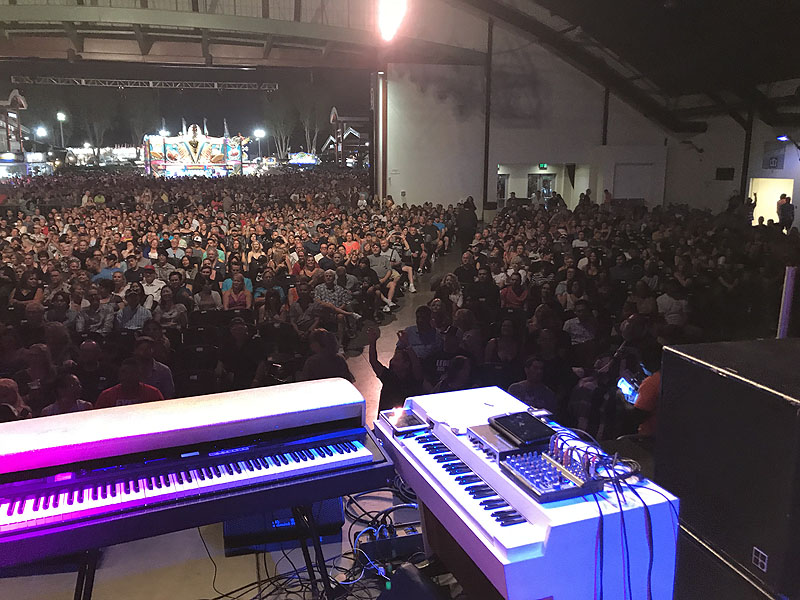
2023 Keyboard Projects
In this Post-COVID Era I've had time and the inclination to dial in the authenticity of my keyboards even more. In 2022 I refinished Faux Rhodes #1, changing the top from gold sparkle to the standard Fender Rhodes black. In August 2023 I completed my 3rd Faux-Mellotron controller, Pellotron #3, sticking as close to the original case dimensions and specs as possible. Similar to #2, this unit disassembles into a case for the controller section, and a large LED bag for the panels. I also built and installed more accurate control plates for my previous two Pellotrons (as I no longer needed the space for an iPad, running everything off a MacBook). These new/improved controllers made their debut at The 2023 OC Fair closing night headliner show with Zeppelin Live in The Hangar, where appx. 80000 people got to witness the flawless functionality (if not operation) of all of my latest musical gear.
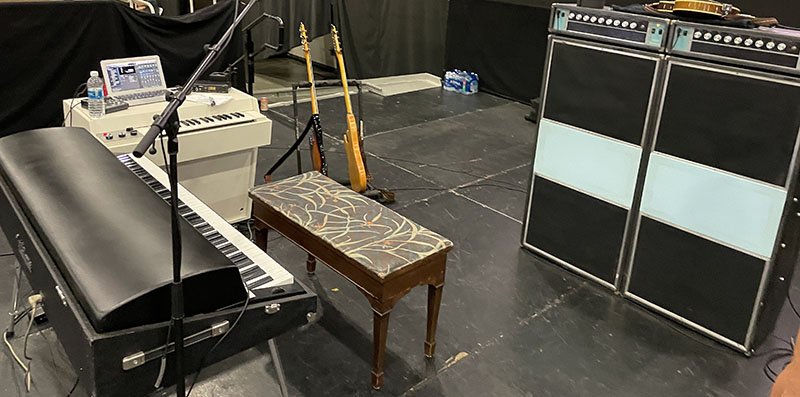

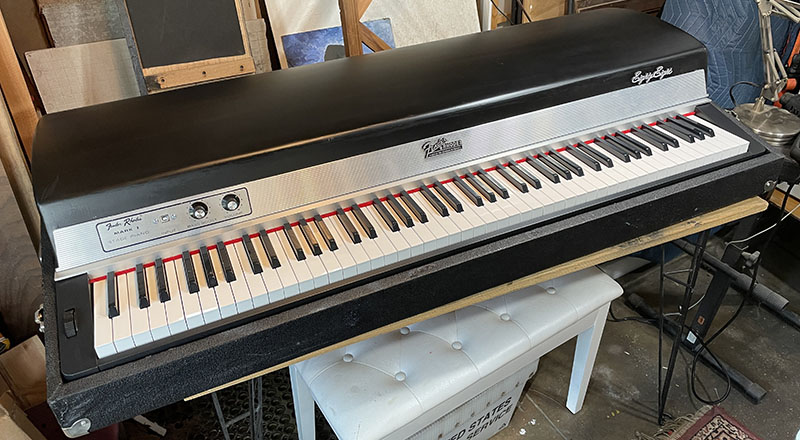
2019 Keyboard Projects
The Pellotron 2.0 disassembles and fits in an LCD bag/case, measuring just inder 50lbs for airline check-in, and now runs the new/improved Mellotronics Streetlytron Pro 1.5 on the iPad (and I believe I'm the first person on the planet with this update, thank you to Phil Atkin at Omenie Limited)

Besides the FauxFisa pictured above (a new gold-top shell to accomodate 2 stop organ-style keyboards), I have been thinking quite a bit about my first attempt at JPJ's Melotron (my Pellotron shell). It has only been on a couple of gigs since built, because it is rather large and difficult to fit on my Hondas with all the other JPJ-required gear (an Element when first built, and now a CRV). What I REALLY need is a Mellotron that can disassemble for easy transport AND weight no more than 50lbd in the case in order to fly as check-in luggage for commercial flights to shows. And so, the need for a Pellotron 2.0.

Based off of the original Mellotron I measured, plus the experience of building my Pellotron 1.0, my first issue would be size and the actual keyboard used for this model. For a few years I have had a rather cheaply-made 37-key MIDI keyboard languishing in my shop. I always knew it would make a GREAT Mellotron keyboard, being (like the real thing) 37 keys and white (which would blend in great), but the keybed was pretty bad, and after only a couple of gigs with it some of the keys continually misfired, so I boxed it (and was tempted to throw it out a few times). I finally got up the nerve to take it apart, realized the issue was the cheap keys without springs losing their ability to snap back, added some foam under all of them, and it's now useable.

Next, materials and weight issues. I need this instrument to disassemble into flat pieces and weigh as little as possible WITH a case (and researching larger cases showed they would weigh up to 30lbs alone). With a 50lb airline checkin limit before extra fees (making it impossible to earn a living doing this stuff) I needed a lighter case and light materials. After purchasing a white kitchen/bath masonite board and almost losing it off the roof of my car on the ride home, I concluded it was way too heavy to use, so I scrapped that and got a sheet of 1/4 luan plywood from Home Depot. I cheated all the edges with strips of 1/2" plywood to give the impression that it was constructed, like the original Mellotrons, with 3/4 wood. I even experimented with using an Apple iPod Touch instead of an iPad Mini (running Mellotron Apps), but the Mini is fine, stable and fits very nicely next to the keyboard (and my Pellotron is even slightly narrower than the originals).
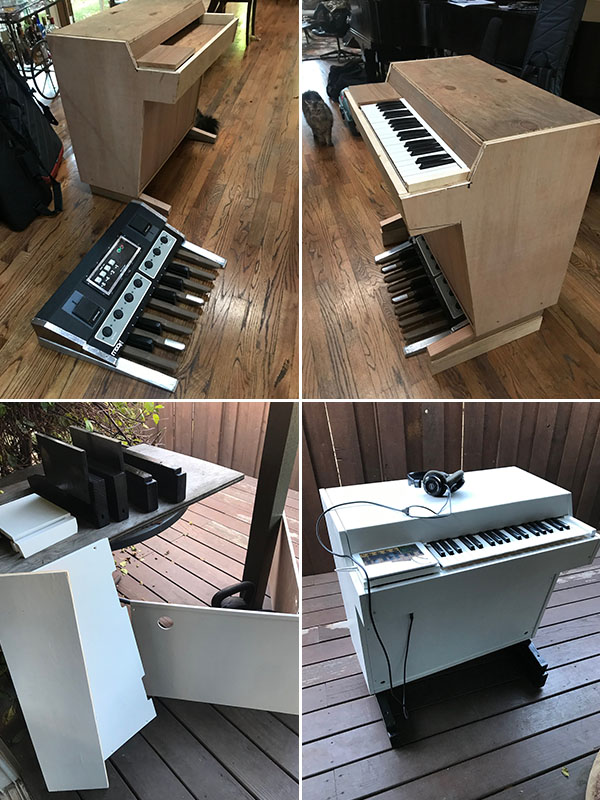
I then had to build the feet and added 2x4 height extensions in order to (just) fit my imitation Moog MOOF bass pedals (so I can play RAIN SONG and KASHMIR from the Mellotron as did JPJ). I finally tracked down a suitable case, a hybrid Gator flat panel LCD/LED bag, which I'm betting will be fine for airline handling once all the parts are packed flat and strapped into the bag. Total weight with the intrument, bag and a light cordless screwdriver to assemble and disassemble is 49lbs!
Pellotron 2.0 with the bag it fits into, at a gig (photobombed by Corey Tarbell, drummer with Mr. Jimmy) and the back (which is all most people see anyway). Next keyboard project will be a mahogany-topped Clavinet, then the Yamaha GX-1 (and I seriously don't know how I'm going to fit that thing in my car).

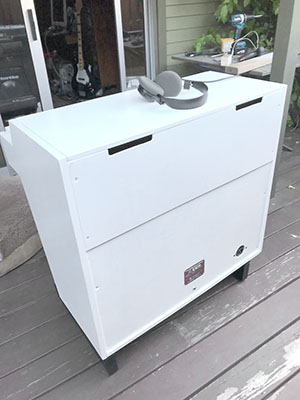
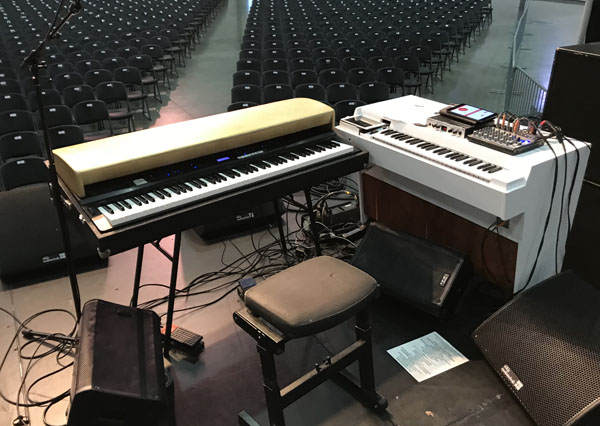
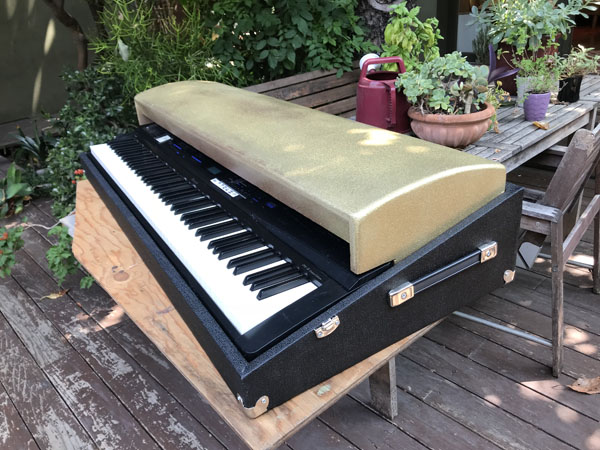
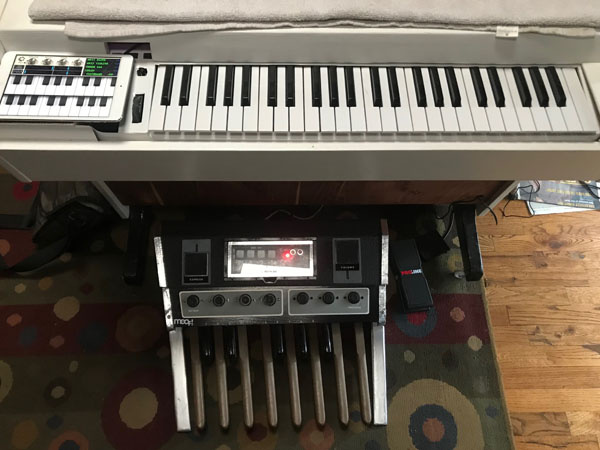
As of July 2018 I've stepped up the "faux-keys" thing (stage and vehicle-space permitting) by encasing my Casio Previa and Line 6 keyboards and controllers in authentic recreations of a Rhodes 88 and Mellotron cases. The basic keyboards and modules I use have not changed (see below), except that I now also have (for certain gigs) a Moog Taurus pedal recreation I call a MOOF! "Aries/Taurus Cusp Pedal" (based on my birth date), which uses an internal MIDI board to access additional key bass parts. If I'm feeling even more ambitious, or have a roadie, I can even bring out a mini grand piano case I gutted (from a Suzuki digital grand piano), which now accommodates a very nice Arturia weighted MIDI controller, firing my chice of grand piano software (currently either the MainStage Steinway Grand or the incredible Pianoteq virtual Grand Piano).
Keyboard setup used for Mr. Jimmy's Led Zeppelin 1977 Live Tour Revival show in Los Angeles /10/2018, including the Rhodes, Mellotron and Bass pedals. In Zeppelin's 1970-71 US tour John Paul Jones used a FARFISA VIP Professional onstage, a rare model with a double register, the sliding pitch pedal thing he used on solos and (later) Dancing Days, and some nice wood and metal work (especially the legs). In preparing Zeppelin's September 1970 Forum show known as BLUEBERRY HILL for the Mr. Jimmy band, I relied on a rather loose interpretation of the case on the Farfisa VIP 255, because there's no way I have the tooling to bend all the metal parts around the wood legs and case to look that perfect (maybe in the next iteration). Using the bottom of the FAUX RHOODES, I made a metallic gold surround and top (with vinyl top of the case to rest the mixer, iPad and other things) around a Nektar 88 and 61-key USB controller, triggering the Roland XV-2020 (for key bass, Hammonds and Rhodes on the 88) and the nice iPad POCKET ORGAN app (on the 61).
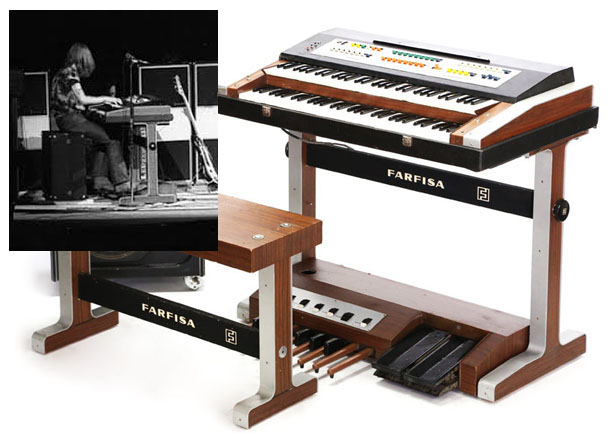
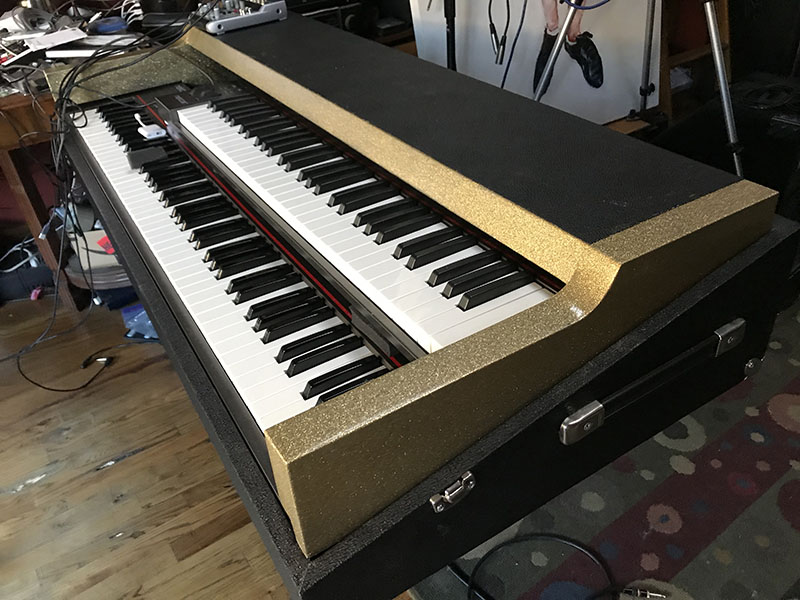
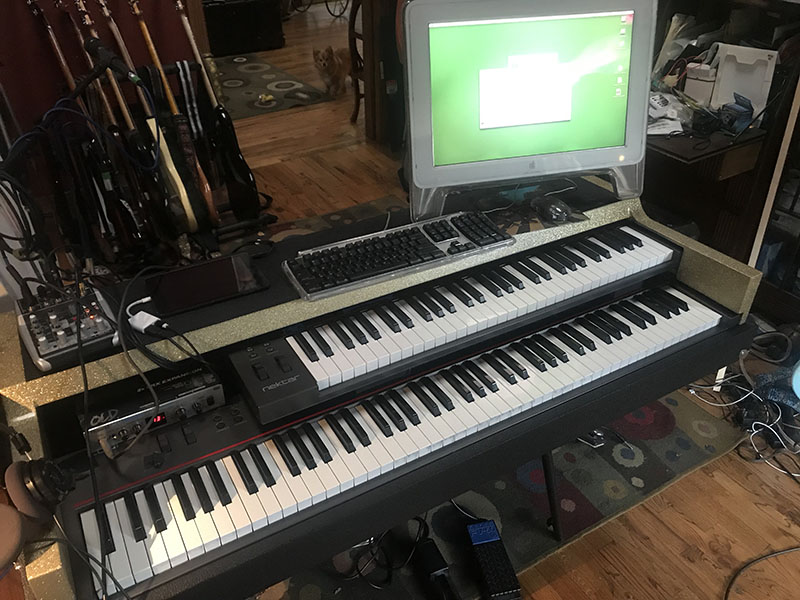
The heart of my standard (and most portable/flyable) keyboard rig is a Casio PX-3 Privia. While the other keyboard manufacturers are still trying to sell digital pianos with realistic action and sound for thousands of $$, this top-of-the-line Casio weighted 88-key digital piano with a wealth of other useful keyboard and acoustic instrument and orchestra samples in only $700, and weighs 25lbs! Besides great grand pianos, it has killer Rhodes and Wurlitzer electric pianos, organs, strings, clavichords and harpsichords. It even has the dead-on phased stereo electric piano for "No Quarter" right out of the box. I have been told previous JPJ's in the bands I play with would take only a synth module and have to rely on a provided keyboard controller at each away gig. I am looking into getting everything put of a Macbook, but for me using someone else's keyboard would be like playing someone else's bass - not always a good thing.
The one essential sound that had to be perfect is the Mellotron - for strings (in "Kashmir" and "The Rain Song") and flutes (in "Stairway"). After trying some key modules (including the Roland XV-2020 below), I came to the conclusion that only a computer-based Mellotron sample program would be right. For 4 years I used the G-Force M-Tron program on a tiny HP Mini Netbook, plugged into my mixer, but I've since transitioned to the iPad M3000HD app. I used to use a tiny USB keyboard for all of the Mellotron parts, but the keyboard so in "All of My Love" is too difficult to play on it, so I now use an Alesis 49-key controller taped to the top of the Casio (it's the smallest and lightest controller with full-sized keys I can find, and a second one now sits inside the Pellotron case).

JPJ played either a Rhodes Keyboard Bass or Taurus pedals running through a bass guitar rig behind him whenever he played keys. Fortunately MIDI was developed shortly after Zep's demise, and I have a couple of bass patches layered in the left hand of the Casio using a half-rack space Roland XV-2020 synth module. I originally got the Roland after researching for a small rack-mount module that would do both good analog-type bass sounds, PLUS a reasonable Mellotron. Even with the Classic Keys expansion card, the Mellotron on this module falls short, but it has not only great bass sounds, but all of the other 70's-style keyboard patches needed for Zep (and almost anything else, from what I can tell). I split the outputs so that the left channel is only key or Taurus bass, and send that into a volume pedal then straight into the bass guitar rig, so the amount of bass energy coming from the stage is identical whether it's bass guitar or key bass (and makes the sound mixer's job easier as well). The right channel goes into a volume pedal and then my little Behringer mixer for other patches including brass (for layered with Casio string section samples for "Kashmir"), the synth strings in "All of My Love", clavichord for "In The Light" and "Trampled," and extra strings and piano for "The Rain Song." Now that IO also have a set of MOOF! "Taurus pedals" I can also perform on vintage or rented instruments if necessary, playing the key bass with my feet (simplified, for sure, but so was JPJ's bass pedal parts), and also live versions of a couple acoustic tunes including playing acoustic guitar and bass pedals on 10 YEARS GONE ala 1977.
When I drive to gigs I bring a brand new pair of amazing QSC K10 powered floor monitors. These things are small, compact, powerful and sound fantastic. They cost as much as the entire keyboard rig, but make my keys sound like they are worth so much more. I really believe that you need things to sound as good as possible on stage in order to be comfortable, and perhaps it will even inspire you to play your best every time. It's easy to get lazy, tired of buying and dragging gear around (did I without roadies? yes, I think I did), but all of the practice, resarch, purchases, programming and setup is worth it, because I have the best seat in the house at every performance.
There's a lot of keyboard sounds to cover when playing Zep, and it took about 4 months to dial this rig in. I still need to nail the keyboard solo sound for "All of My Love" better; I can't find something suitable in the Roland, and the iPad Mellotron sax is "close but not quite." I am looking into creating the patch on the Roland, then possibly sampling it for the M-Tron application so I can play it on the Alesis keyboard (or layer it to play at the top of the Casio controller). There's always room for improvement, and I am never 100% satisfied, which keeps me practicing and working on additional keyboard patches. I would love to play the intro to "In The Light" live instead of the band running a CD of it before they go on, and maybe someday I can get a band to perform "I'm Gonna Crawl" at least once...
Close-up videos of the keyboard tunes are posted on the Songs page.
© 2011-25 Joel Pelletier, email: joelp@johnpauljoel.com
Updated 02 May 2025Joel, Pelletier, joelpelletier, joelp, independent, indie, Los Angeles, chamberpop, chamber pop, chpop, realtime, (real)time, real, time, mp3, free, audio, video, CD, CD-ROM, DVD, enhanced, album, project, rock, pop, songs, music, lyrics, classical, acoustic, electric, hybrid, genre, art, artist, multimedia, painter, composer, arranger, producer, musician, multi-instrumentalist, solo, band, bass, double bass, guitar, drums, piano, cello, violin, viola, orchestra, quartet, string, arrangement, orchestration, studio, live, perform, tour, america, europe, asia, free, buy, donate, donation, download, mp3, digital, analog, surround, 5.1, QuickTime, animation, illustrations, images, media, Real, steinberger, NAMM, EAW, mackie, way home, web designer, Beethoven, Stravinsky, Bartok, Berg, Hindemith, John Lennon, Beatles, Crowded House, George Martin, Peter Gabriel, Sting, XTC, Paul Simon, Joe Jackson, translations, american, english, french, spanish, portuguese, german, italian, russian, swedish, chinese

